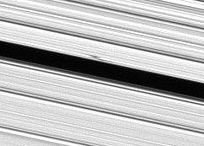
A | B | C | D | E | F | G | H | CH | I | J | K | L | M | N | O | P | Q | R | S | T | U | V | W | X | Y | Z | 0 | 1 | 2 | 3 | 4 | 5 | 6 | 7 | 8 | 9





A moonlet, minor moon, minor natural satellite, or minor satellite is a particularly small natural satellite orbiting a planet, dwarf planet, or other minor planet.
Up until 1995, moonlets were only hypothetical components of Saturn's F-ring structure, but in that year, the Earth passed through Saturn's ring plane. The Hubble Space Telescope and the European Southern Observatory both captured objects orbiting close or near the F-ring. In 2004, Cassini caught an object 4–5 kilometers in diameter on the outer ring of the F-ring and then 5 hours later on the inner F-ring, showing that the object had orbited.[1]
Several different types of small moons have been called moonlets:
- A belt of objects embedded in a planetary ring, especially around Saturn, such as those in the A Ring, S/2009 S 1 in the B Ring ("propeller" moonlets),[2][3] and those in the F Ring[4]
- Occasionally asteroid moons, such as those of 87 Sylvia[5]
- Flashes seen near Jupiter's moon Amalthea that is likely debris ejected from its surface[6]
- Subsatellites[7]
See also
References
- ^ Winter, Othon C.; et al. (2007). "Moonlets wandering on a leash-ring". Monthly Notices of the Royal Astronomical Society: Letters. 380 (1): L54–L57. Bibcode:2007MNRAS.380L..54W. doi:10.1111/j.1745-3933.2007.00347.x. hdl:11449/33832.
- ^ Tiscareno, Matthew S.; et al. (2006). "100-metre-diameter moonlets in Saturn's A ring from observations of 'propeller' structures". Nature. 440 (7084): 648–650. Bibcode:2006Natur.440..648T. doi:10.1038/nature04581. PMID 16572165. S2CID 9688977.
- ^ Sremčević, Miodrag; et al. (2007). "A belt of moonlets in Saturn's A ring". Nature. 449 (7165): 1019–1021. Bibcode:2007Natur.449.1019S. doi:10.1038/nature06224. PMID 17960236. S2CID 4330204.
- ^ Murray, Carl D.; et al. (June 5, 2008). "The determination of the structure of Saturn's F ring by nearby moonlets" (PDF). Nature. 453 (7196). The Science and Technology Facilities Council: 739–44. Bibcode:2008Natur.453..739M. doi:10.1038/nature06999. PMID 18528389. S2CID 205213483.
- ^ Marchis, Franck; et al. (2005). "Discovery of the triple asteroidal system 87 Sylvia". Nature. 436 (7052): 822–24. Bibcode:2005Natur.436..822M. doi:10.1038/nature04018. PMID 16094362. S2CID 4412813.
- ^ Fieseler P. D.; Adams O. W.; Vandermey N.; Theilig E. E.; Schimmels K. A.; Lewis G. D.; Ardalan S. M.; Alexander C. J. (2004). "The Galileo star scanner observations at Amalthea". Icarus. 169 (2): 390–401. Bibcode:2004Icar..169..390F. doi:10.1016/j.icarus.2004.01.012.
- ^ Walker, Robert (17 April 2015). "Can Moons Have Moonlets? Or Rings? Moonlets Of Pluto's Moons?". Science 2.0. Retrieved 9 April 2016.
Further reading
Links
Text je dostupný za podmienok Creative Commons Attribution/Share-Alike License 3.0 Unported; prípadne za ďalších podmienok. Podrobnejšie informácie nájdete na stránke Podmienky použitia.
Antropológia
Aplikované vedy
Bibliometria
Dejiny vedy
Encyklopédie
Filozofia vedy
Forenzné vedy
Humanitné vedy
Knižničná veda
Kryogenika
Kryptológia
Kulturológia
Literárna veda
Medzidisciplinárne oblasti
Metódy kvantitatívnej analýzy
Metavedy
Metodika
Text je dostupný za podmienok Creative
Commons Attribution/Share-Alike License 3.0 Unported; prípadne za ďalších
podmienok.
Podrobnejšie informácie nájdete na stránke Podmienky
použitia.
www.astronomia.sk | www.biologia.sk | www.botanika.sk | www.dejiny.sk | www.economy.sk | www.elektrotechnika.sk | www.estetika.sk | www.farmakologia.sk | www.filozofia.sk | Fyzika | www.futurologia.sk | www.genetika.sk | www.chemia.sk | www.lingvistika.sk | www.politologia.sk | www.psychologia.sk | www.sexuologia.sk | www.sociologia.sk | www.veda.sk I www.zoologia.sk
